 Research Update
Research Update
08
Dec
On November 26, 2017, the Report Meeting of “China Macroeconomic Forum (2017-2018)” jointly organized by National Academy of Development and Strategy (NADS) and School of Economics, Renmin University of China (RUC) and China Chengxin Credit Management Co., Ltd. was held in RUC under the theme of “China’s Macro Economy as Its New Normal Enters a New Stage”.
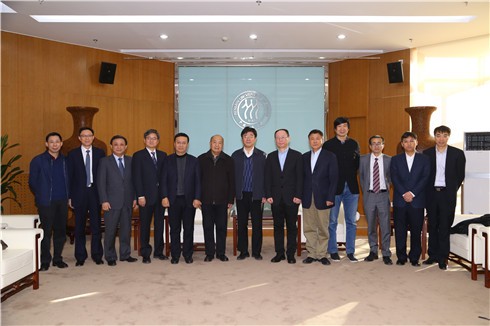
In attendance were experts and scholars including Liu Wei, RUC President and Dean of RUC NADS, Hu Naiwu, a first grade professor at RUC, Wang Yiming, Director of Development Research Center of the State Council, Gao Peiyong, member of Chinese Academy of Social Sciences (CASS) and Director of Institute of Economic CASS, Zhang Yansheng, Researcher of the Academic Committee of National Development and Reform Commission (NDRC) and Chief Researcher of China Center for International Economic Exchanges (CCIEE), Zhang Ping, Deputy Director of National Institution for Finance & Development (NIFD) CASS, Liu Yuanchun, Vice President of RUC and Executive Dean of RUC NADS, Mao Zhenhua, Co-director of the Institute of Economic Research, RUC, Yang Ruilong, Co-director of the Institute of Economic Research, RUC, Yan Yan, Chairman of China Chengxin International Credit Rating Co., Ltd. and Co-Deputy Director of Institute of Economic Research, RUC, Guo Jie from School of Economics, RUC, Chen Yanbin, Deputy Dean of School of Economics, RUC and Zhu Rong, Deputy Director of Institute of Economic Research, RUC.
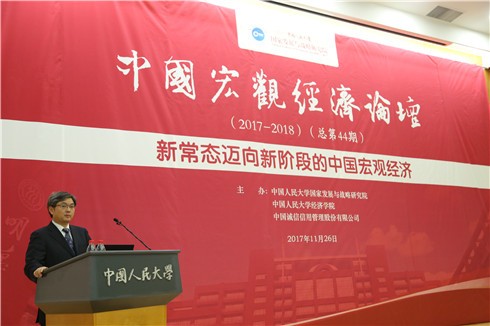
Session I of the Forum was presided over by Yang Ruilong, Co-director of Institute of Economic Research, RUC.
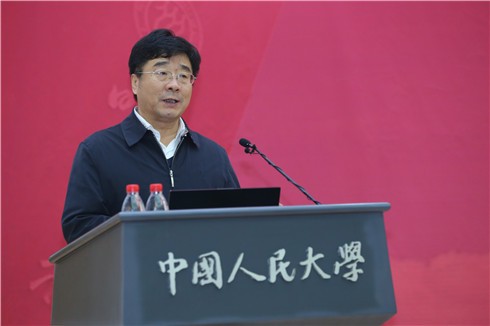
RUC President Liu Wei extended his warm welcome and heartfelt thanks to all the guests present. He said that the Report to the 19th CPC National Congress issued a new signal of China’s economy in the new era, untangled key issues of economic development and set the tone of future reform roadmap, providing significant information for the trend of economic policies, indicating the direction of China’s economic development and offering important ideas to academic research. China Macroeconomic Forum is expected to bring into play the academic strength as always and apply research findings and academic views of the Forum to great practices for economic development and social progress in China based on RUC’s advantageous disciplines and academic atmosphere, the Motto of seeking truth from facts and the professionalism and social responsibility of RUC, thus truly playing the key role as a national high-end think tank in providing suggestions on the policies and enlightening people.
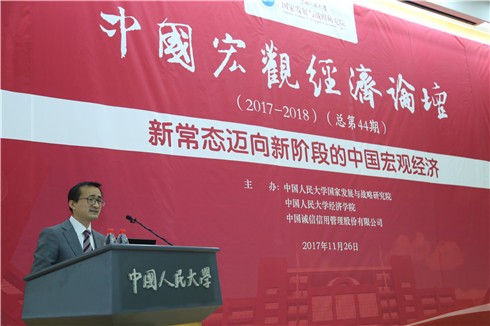
On behalf of the Research Group, Liu Yuanchun, Vice President of RUC and Executive Dean of RUC NADS, released the theme report of the Forum: China’s Macro Economy As Its New Normal Enters a New Stage.
The reports indicate that in 2017, China's macro economy rebounds after hitting bottom and running stable under the combined effect of factors such as synchronous recovery of world economy, continuously working policies for stable growth, advancement of supply-side structural reform in all respects, a rapid growth of new economic drivers and constantly improved market expectation. Macroscopic prospect, microscopic performance, restructuring and cultivation of new drivers are continuously improved, and the economy generally presents a "stable and improved" recovery better than expected. All these show that China has achieved a phased win in its macroeconomic restructuring.
A deep probe into the nature of such better-than-expected recovery suggests that the steady growth of China's economy in 2017 is generally policy-driven and restorative, and market forces and the trend are not stable, so China's macro economy presents the following three features requiring special attention: 1) the economy has registered a stable performance but can hardly rebind fast, and being stable and slow might be the New Normal; 2) risks have been alleviated but not eliminated, and local problems might worsen; 3) the structure is faced with the impact of policy-based exit despite an improvement.
These features indicate that China's economy has not yet ushered in the new cycle of a constant rebound and the New Normal is far from over, but the New Normal does enter a new stage. For some time to come, the New Normal of China's economy will face new environment, problems, and contradictions different from those over the past five years and present the following eight operating features and rules: 1) economic growth will turn from "a rapid downturn" to a "stable and slow recovery" and the drive of such growth will turn from the combination of "trend" and "periodicity" to that of "policy exit" and "trend". 2) The restructuring will transform from being "government-led" and "external impact-based" to being market-led and mainly endogenous. 3) The momentum will transit from parallel "government support and market development" in the past to the stage of "the market playing a dominant role and the government auxiliary", with the transformation of drivers entering a critical stage. 4) Economic policies will come to the stage of "gradual exit" from that of "continuous expansion". 5) The world economy will come to "the stage of slow recovery and policy exit" from "long-term stagnation" over the past decade while China's trade surplus will come to the stage of "low-level stabilization" from that of "rapid decline" in the past and capital account will come to the stage of "relatively balanced fluctuation" from that of "panic outflow". 6) The financial cycle will go down and risk release will become more sudden and hidden. 7) Reform will step into a pivotal stage when new institutional dividends will be established. The reform mode will turn from the simple "reform of the market or economy itself" in the past to the establishment of a national governance system in all respects, so as to lay power, administrative and social foundations for the economic reform through power reconstruction, administrative system reform and social reform, and supply-side structural reform will be deepened amid acceleration of such administrative system reform and social reform. 8) Economic development will enter a "high-cost period" and cost-push inflation might be a great concern in future.
In 2017, China’s macro economy presents a weak recovery based on the situation of bottoming out and running stable in 2016. The actual GDP growth rate is estimated to be 6.8% throughout 2017, rebounding by 0.1% over 2016, and the nominal GDP growth rate is estimated to be 11.0%, representing a sharp increase of 3.1% over 2016, which shows improvements in the economy beyond market expectations; the producer price index (PPI) rebounds across the board by 7.7% over 2016 to 6.3%, making the industry out of depression for 55 consecutive months; the external environment is improved in that the export growth rate is estimated to reach 7.5%, rebounding by 15.2% over 2016, and the import growth rate is estimated to reach 17.4%, rebounding by 22.9% over 2016; whilst the consumption boom remains unchanged, investment growth rate continues to drop, which is estimated to be 7.3% throughout the year, a 0.3% decrease over 2016, and if the price factor is considered, the actual growth rate of investment in fixed assets has decreased by 5.5%. That the investment growth rate does not hit the bottom and remain stable implies the new macroeconomic cycle has not begun yet.
In 2018, China’s macro economy will maintain relatively steady growth. The actual GDP growth rate is estimated to be 6.7% in 2018, representing a slight decrease of 0.1% over 2017; but given a 3.7% decrease in GDP deflator, the nominal GDP growth rate is estimated to be 10.4% in 2018, representing a decrease of 0.6% over 2017. Specifically, the growth rate of the primary industry will remain basically the same, while that of the secondary and tertiary industries will be 6.1% and 7.7% respectively, both slightly decreasing by 0.1% over 2017; despite a slowdown of the rapid decline in the growth of investment in fixed assets, the weakness of such investment can hardly be reversed fundamentally, with the growth rate throughout the year estimated to be only 7.3%. The consumption boom will remain, with an estimated growth rate of 10.5%; improvements in the external environment can hardly hit a new high, with estimated export growth rate of 8.5%, import growth rate of 12.0% and a trade supply of USD 358.7 billion, representing an 8.2% decrease over 2017; with a rise in China Commodity Price Index (CCPI), production cost transmission and high base effect, the margin of PPI rise will decrease while that of CPI rise will increase, narrowing the gap between CPI and PPI, with estimated CPI rise of 2.3%, PPI rise of 4.6% and GDP deflator index of 3.7% throughout the year.
Based on these judgments and estimates, the report puts forward a series of policy suggestions:
1. A scientific understanding should be established of the better-than-expected stabilization of China’s macro economy in 2017 and the “new cycle” concept should be fundamentally objected as expansive macroeconomic policies have not yet come to the time point of complete exit.
2. The understanding and judgment of the medium-term perspective of China's economy must be strengthened. In-depth studies of new contradictions, problems, operating mechanisms and rules as the New Normal enters a new stage should be carried out to deepen the theory of New Normal of the economy proposed by General Secretary Xi and provide a theoretical reference for the economic work in the coming years.
3. The new cycle has not started in China, so China’s expansive macroeconomic policies have not come to the time point of complete exit. The positioning of generally positive macroeconomic policies should not be changed before the growth of investment in fixed assets hits the bottom and becomes stable. Given the fact that the real economy recovers at a far lower rate than the virtual economy, the normalization of China’s macroeconomic policies should be slower than that in Western countries and be synchronized with the recovery of the internal impetus of the market.
4. In view of a stage win in stable growth and a significant improvement in the resilience of China's economy, the core objective of China’s macroeconomic regulation in 2018 should moderately turn from “stabilizing growth” to “promoting reform” based on “controlling risks”, and the year of 2018 will be a window period for China to introduce a key reform deepening plan in the new stage of the New Normal across the board. 1) Efforts should be made to sort out reform tasks and measures proposed in the 19th CPC National Congress as early as possible and put forward a reform plan in the new stage of the New Normal in line with the overall objective of comprehensively deepening reform set out by the CPC Central Committee. 2) It should be clear that comprehensively deepening reform in the new era must jump out the past paradigm and should start with government system reform and social reform, so as to lay power, administrative and social foundation for the economic system reform. 3) The core of the market system reform lies in eliminating various "soft constraints", especially those between the government and banks, between the government and enterprises and between banks and state-owned enterprises. Therefore, rebuilding a behavioral model for state-owned enterprises through the reform of such enterprises, re-establishing a behavioral model for banks through the reform of the regulatory system and financial system, and reconstructing power boundaries and a behavioral model for the government through the reform of the administrative system are the key to solving the "peace-turbulence cycle" in the past. The behavioral model of microcosmic subjects changes with the interests boundary and also causes changes in the way and efficiency of resources allocation, so excessively macroscopic regulation can hardly change the mode of resources allocation or overcome the government failure in the administration and the subsequent "double-failure cycle". 4) Supply-side structural reform should be further deepened and expanded, but should serve basic and key reforms in the course of law enforcement and regularization; efforts should be made to prevent generalization and virtualization of supply-side structural reform in the process of deepening such reform, so as not to miss the key window period for an overwhelming victory in comprehensively strengthening the Party discipline and comprehensively deepening reform based on stable economic development in the new era.
5. It is recommended that China’s economic growth objective in 2018 can be appropriately played down based on the emphasis on the objective of 11 million jobs; the price level objective may be set at 2.5% and attention should be paid to price rises at specific time points; M2 growth rate should not be lower than 11% and the growth rate of total social financing can be set at around 12.5%; the nominal fiscal deficit ratio can be maintained at 3%, but the broad fiscal deficit ratio should be properly reduced; the target exchange rate should have a properly higher margin whilst remaining stable, with the average level against the dollar maintained at around 6.7:1.
6. At present, China should pay high attention to the faster decline in the actual growth of investment in fixed assets and the core of stable growth in 2018 should lie in “stable investment”, but significant adjustments must be made to the direction and tools of corresponding policies: most importantly, measures such as protection of property rights, new room for capital investment, reduction of investment costs and expansion of investment demand should be taken to activate private capital. It is recommended to introduce a systematic plan for the launch of private investment in 2018. It should be understood that low return on entity investment is not merely a periodic phenomenon and more importantly, is originated from the absence of series major reforms. The systematic plan to activate private capital must contain a large number of basic and medium-term major reforms: firstly, the government must gradually transform from the current investment-oriented government to a livelihood-oriented one; secondly, the investment system and profit use of state-owned enterprises should be strategically re-positioned and reformed, and investment in non-main business must be strictly restricted; thirdly, regulatory measures and policies should be re-organized; fourthly, the market-oriented reform of public institutions and the public service system must be deepened; fifthly, supply-side structural reform should be further intensified in respect of “cost reduction”.
7. “Systems and mechanisms that promote consumption should be perfected and the basic role of consumption in economic development should be strengthened”. Consumption must be promoted from a more macroscopic and dynamic perspective instead of being stimulated in respect of consumption itself. 1) Supply-side structural reform should be aligned with consumption to promote the release of supply and demand of high- and mid-end consumer goods, for which the high- and mid-end consumption promotion strategy corresponding to the strategy of subsidies for poverty alleviation may be adopted. 2) Housing prices should be strictly controlled and real estate supply should be done by multiple subjects through multiple channels to comprehensively solve the housing problem and reduce excess expenditures on real estate out of resident income, thus reducing residents’ housing savings and leaving more income for consumption. 3) Public services should be expanded and people’s livelihood construction should be accelerated to reduce residents’ prudent savings for old age, healthcare, education and other services and increase the consumption ratio. 4) Dividends to be paid in enterprises should be increased, especially in state-owned enterprises, to prevent enterprise profits from automatically turning into investment funds and enterprise savings from occupying consumption funds. 5) Government functions should be actively transformed, so that current government investments in various industries can drop significantly and go to public services and construction of livelihood projects.
8. In the process of financial clean-ups and deepening of the financial system reform, China’s monetary policies in 2018 should follow the positioning in 2017, but may operate in a properly eased manner. 1) M2 growth rate should not be set too low, the growth rate of total social financing should not be up-regulated too fast, and the level of interest rates should not rise too fast in the short run. 2) In 2018, money supply may be accomplished through gradual reduction of the deposit-reserve ratio of financial institutions. 3) Apart from commonly used open market operation instruments, monetary policies such as standing lending facility, medium-term lending facility and other innovative instruments should be made to inject liquidity into the market, so as to strengthen the guidance of market expectations. 4) By reference to international experience, efforts should be made to establish a clear interest rate corridor mechanism, determine the benchmark interest rate of monetary policies as early as possible, strengthen the guidance of the operation of monetary policies on the benchmark interest rate, get out of the attention on both interest rates and scale of operation, and truly make price regulation more normal. 5) Credit scale regulation should be weakened in MPA (macro-prudential assessment). 6) A correct understanding should be established of the normalization of US dollar interest rate, reduction in the Fed's balance sheet and normalization of monetary policies in other developed countries in 2018. 7) Chinese financial regulators must pay high attention to prerequisites to and ways to control "microcosmic debt-to-equity swap" and "macrocosmic debt-to-equity swap", and should not simply copy the de-leveraging in European and American countries. 8) Macro prudential regulation must tilt towards structural factors from indicators of systematic financial risks, and monitoring of debt sustainability risks in key cities, provinces, industries, and enterprises should be intensified.
9. China’s fiscal policies in 2018 should continue to be positive, but the broad fiscal deficit ratio that has been rising too fast should be a core concern in the adjustment to fiscal policies. In 2018, the nominal fiscal deficit ratio may still be set at 3%, but various implicit debts must be substantially managed and controlled, and close attention should be paid to global tax competition resulting from tax reduction in the USA.
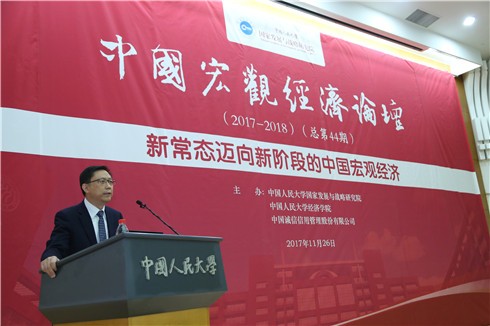
Session II was presided over by Yan Yan, Chairman of China Chengxin International Credit Rating Co., Ltd. and Co-Deputy Director of Institute of Economic Research, RUC. In the session, experts and guests present had in-depth discussions and exchanges on issues concerning China's macroeconomy.